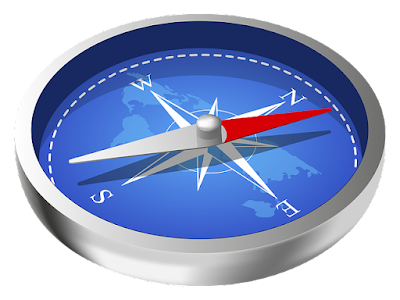A compass is a navigational tool that uses the Earth's magnetic field to determine direction. It's a crucial instrument for outdoor activities like hiking, camping, orienteering, and navigation. Let's delve into how a compass works and how to use it:
How a Compass Works:
Magnetic Needle:
- A compass consists of a magnetic needle, typically marked with a red or orange end (north-seeking) and a white or silver end (south-seeking).
Earth's Magnetic Field:
- The Earth has a magnetic field with magnetic north and magnetic south poles. The magnetic needle aligns itself with this field, with one end pointing towards magnetic north and the other towards magnetic south.
Magnetic Declination:
- Magnetic north is not exactly aligned with true geographic north (the North Pole). The angular difference between magnetic north and true north is called magnetic declination. It's essential to adjust for this difference when using a compass for accurate navigation.
How to Use a Compass:
Hold the Compass Level:
- Hold the compass flat in your palm, ensuring it's level and not tilted.
Find the Orienting Arrow:
- Look for an orienting arrow or indicator on the base of the compass housing. This arrow is crucial for aligning the compass with the direction you want to go.
Align the Compass:
- Rotate the compass housing until the orienting arrow aligns with the magnetic needle, ensuring the needle rests within the outlined orienting arrow.
Read the Bearing:
- The direction you want to go is now indicated by the direction of the orienting arrow. Read the bearing (in degrees) at the direction-of-travel arrow on the base of the compass housing.
Follow the Bearing:
- Hold the compass steady and turn your body until the magnetic needle aligns with the orienting arrow. The direction-of-travel arrow now points the way you want to go.
Navigate:
- Maintain the needle within the orienting arrow as you move, keeping your desired direction by following the direction-of-travel arrow.
Tips for Using a Compass:
Calibration: Ensure your compass is calibrated and free from any magnetic interference (metal, electronics) that could affect its accuracy.
Magnetic Declination: Adjust your bearing for magnetic declination based on your location to get a true direction.
Practice: Practice using a compass in a familiar area before relying on it in unfamiliar or challenging terrain.
Map and Compass Integration: Learn how to use a map in conjunction with a compass for more advanced navigation.
By understanding how a compass works and practicing its use, you'll gain confidence in navigating through different terrains and environments accurately. Always prioritize safety and double-check your navigational decisions.


No comments:
Post a Comment